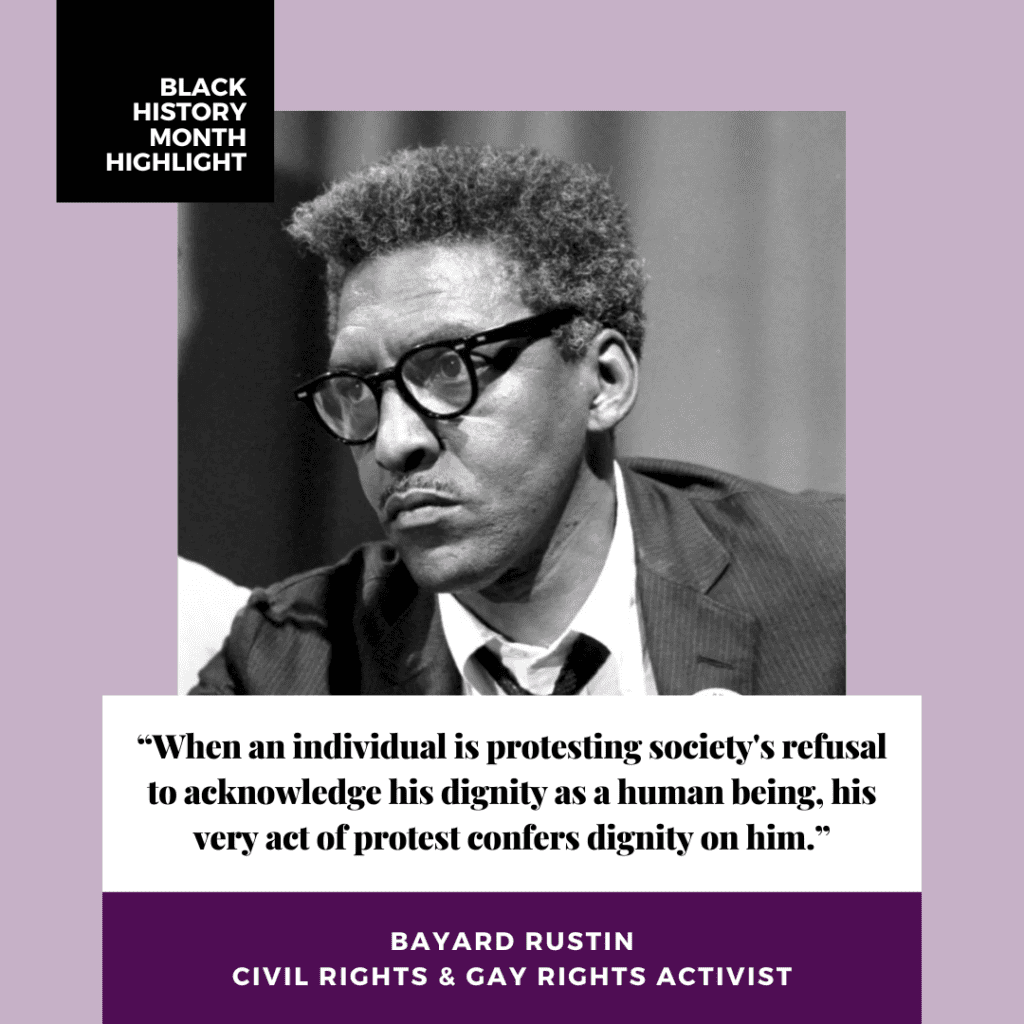February is Black History Month and we’re celebrating Black individuals from the past and present day who have changed the course of history and strengthened our communities. Black History is relevant every day, but we celebrate in February to honor ancestor Frederick Douglass, who was born enslaved and did not know his actual birth date but chose to celebrate it on Feb. 14. Frederick Douglass is known as the father of the civil rights movement. He rose through determination, brilliance, and eloquence to shape the American nation. He was an abolitionist, human rights and women’s rights activist, orator, author, journalist, publisher, and social reformer. You can learn more about his incredible life and work here.

Rev. Dr. Pauli Murray was a twentieth-century human rights activist, legal scholar, feminist, author, poet, Episcopal priest, labor organizer, and multiracial Black, LGBTQ+ community member.
A member of the Fellowship of Reconciliation, Murray worked to end segregation on public transport. In March 1940, they were arrested and imprisoned for refusing to sit at the back of a bus in Virginia. In 1941, Murray enrolled at the law school at Howard University with the intention of becoming a civil rights lawyer. The following year Murray joined George Houser, James Farmer, and Bayard Rustin to form the nonviolence focused Congress of Racial Equality. Pauli Murray was first in her class at Howard University Law school and the only woman. She is the first African American to earn a J.S.D. from Yale Law School and a co-founder of the National Organization for Women. In 1977, Murray became the first African American woman to be ordained as an Episcopal priest.
When the Rev. Dr. Pauli Murray lived, language about LGBTQ+ communities, gender expression, and gender was different than it is today. We don’t know how Pauli Murray would identify if they were living today or which pronouns Murray would use for self-expression. For years, Murray requested – and was denied – testosterone injections and hormone therapy, as well as exploratory surgery to investigate their reproductive organs, believing that they may have been intersex. There is so much more to learn about Rev. Dr. Pauli Murray’s life. Learn more about Murray’s story and read their extensive written work at paulimurraycenter.com.
Legend has it that our Minneapolis house is an important piece of Black History! It’s believed that the house was once headquarters for the Minnesota Black Panther Party. Bobby Seale, co-founder of the Black Panther Party for Self-Defense, alongside co-founder Huey P. Newton, left an indelible mark on the course of American history and inspired generations of activists. Bobby’s legacy and his bravery has always been relevant and found new poignancy in the last few years as communities across the country, starting in Minneapolis, grappled with police brutality and institutionalized racism. The Black Panthers found its original footing as an organization that monitored the police in Oakland, CA and challenged (verbally, politically, and literally physically) police brutality.
In his college years Bobby joined the Afro-American Association at Merrick College and learned about African and African-American history. He met Huey P. Newton there and the two initiated anti-poverty, Black history, and self-sufficiency programs in Oakland. The Black Panther Party was born out of this early work. Bobby and Huey penned the famous 10 Point Platform of the Black Panther Party, whose goals still resonate today and mirror much of the work being done at Avenues. These social demands included the freedom of self-destiny for the Black community, full employment, housing, a true history education of Black Americans, as well as real justice and accountability for police brutality and racism. Bobby Seale is still alive and well. He is still active for social justice, political representation, speaks to groups across the country, and also has a delicious cookbook with all the best BBQ recipes.
Jessica Watkins is a NASA Astronaut and the first Black woman to join the International Space Station Crew and only the fifth Black woman ever to travel into space. Jessica Watkins was selected by NASA to join the 2017 Astronaut Candidate Class. Watkins reported for duty in August 2017 and completed two years of training as an astronaut candidate. The Colorado native earned a Bachelor of Science in geological and environmental sciences from Stanford University, and a Doctorate in geology from the University of California, Los Angeles (UCLA). Dr. Watkins conducted her graduate research on the emplacement mechanisms of large landslides on Mars and Earth. She has worked at NASA’s Ames Research Center and NASA’s Jet Propulsion Laboratory, and was a science team collaborator for NASA’s Mars Science Laboratory rover, Curiosity. Watkins served as a mission specialist on NASA’s SpaceX Crew-4 mission to the International Space Station, which concluded on Oct. 14, 2022. It was the first spaceflight for Watkins, and the first flight of the Crew Dragon “Freedom” spacecraft. During the mission, she spent 170 days in space maintaining the space station and contributing to science experiments that not only might improve life on Earth, but also allow researchers to learn more about the effects of long duration spaceflight on the human body.
Aside from completing her mission on the ISS, Watkins is among the 18 astronauts selected to join NASA’s Artemis team who will be the first to step on the moon since the Apollo missions 50 years ago. The Artemis program will include the first woman and the first person of color to reach Earth’s natural satellite. Read more about Jessica’s incredible experience, education, and work as a scientist and explorer here.

Bayard Rustin was a brilliant strategist, pacifist, and forward-thinking civil rights activist during the middle of the 20th century. In 1947 as a member of the Fellowship of Reconciliation, Rustin planned the “Journey of Reconciliation,” which would be used as a model for the Freedom Rides of the 1960’s. He served as a mentor to Martin Luther King, Jr. in the practice of nonviolent civil resistance, and was an intellectual and organizational force behind the burgeoning civil rights movement during the 1950s and 1960s. He organized protests in England and studied Ghandian principles in India.
His life as an openly gay man, however, put him at odds with the cultural norms of the larger society and left him either working behind the scenes or outside of the movement for stretches of time. With the passage of the Civil Rights Act of 1964 and the Voting Rights Act of 1965, his talents and tireless work were transferred to human rights and the gay rights movement. In the 1970s and 1980s he worked as a human rights and election monitor for Freedom House. In the 1980s, he became a part of the LGBTQ+ movement and an advocate for AIDS education. In a 1986 testimony on behalf of New York State’s Gay Rights Bill, Rustin stated that “gay people are the new barometer for social change.” He felt that injustice everywhere should not be tolerated and must be protested. You can learn more about Bayard Rustin and his contributions from The National Museum of African American History & Culture. There’s also a biographical movie of his life on Netflix, titled “Rustin.”
